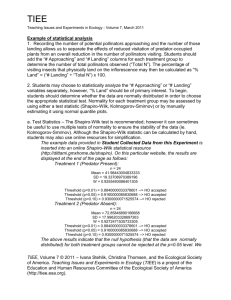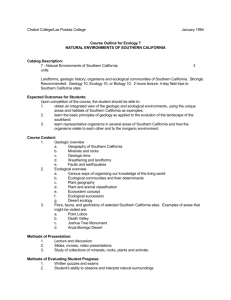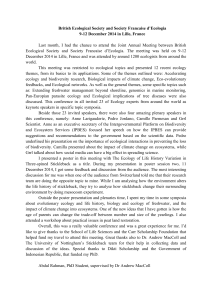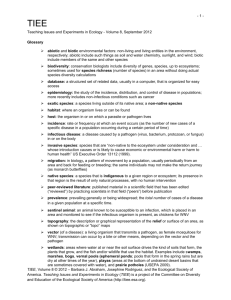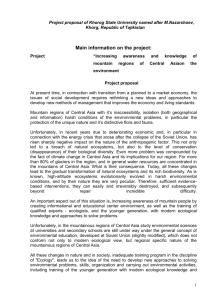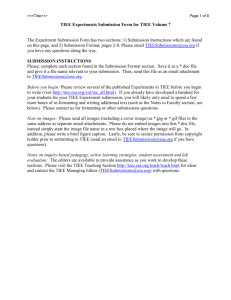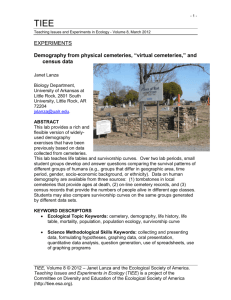Holyoke Faculty PDF.doc
advertisement
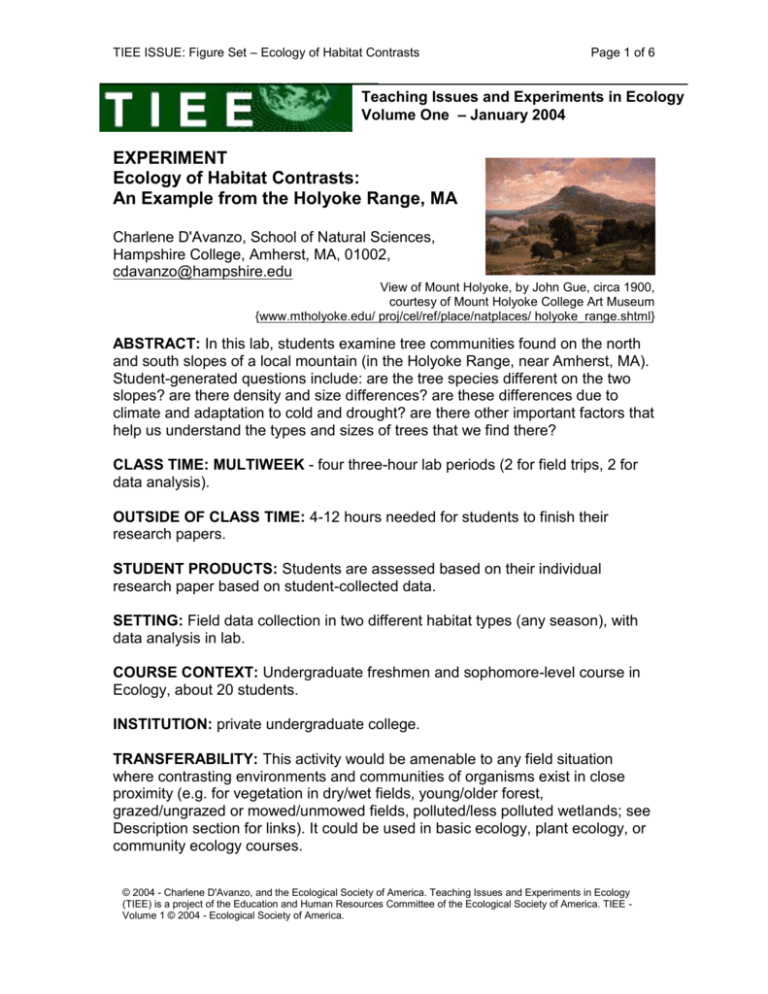
TIEE ISSUE: Figure Set – Ecology of Habitat Contrasts
TIEE
Page 1 of 6
Teaching Issues and Experiments in Ecology
Volume One – January 2004
EXPERIMENT
Ecology of Habitat Contrasts:
An Example from the Holyoke Range, MA
Charlene D'Avanzo, School of Natural Sciences,
Hampshire College, Amherst, MA, 01002,
cdavanzo@hampshire.edu
View of Mount Holyoke, by John Gue, circa 1900,
courtesy of Mount Holyoke College Art Museum
{www.mtholyoke.edu/ proj/cel/ref/place/natplaces/ holyoke_range.shtml}
ABSTRACT: In this lab, students examine tree communities found on the north
and south slopes of a local mountain (in the Holyoke Range, near Amherst, MA).
Student-generated questions include: are the tree species different on the two
slopes? are there density and size differences? are these differences due to
climate and adaptation to cold and drought? are there other important factors that
help us understand the types and sizes of trees that we find there?
CLASS TIME: MULTIWEEK - four three-hour lab periods (2 for field trips, 2 for
data analysis).
OUTSIDE OF CLASS TIME: 4-12 hours needed for students to finish their
research papers.
STUDENT PRODUCTS: Students are assessed based on their individual
research paper based on student-collected data.
SETTING: Field data collection in two different habitat types (any season), with
data analysis in lab.
COURSE CONTEXT: Undergraduate freshmen and sophomore-level course in
Ecology, about 20 students.
INSTITUTION: private undergraduate college.
TRANSFERABILITY: This activity would be amenable to any field situation
where contrasting environments and communities of organisms exist in close
proximity (e.g. for vegetation in dry/wet fields, young/older forest,
grazed/ungrazed or mowed/unmowed fields, polluted/less polluted wetlands; see
Description section for links). It could be used in basic ecology, plant ecology, or
community ecology courses.
© 2004 - Charlene D'Avanzo, and the Ecological Society of America. Teaching Issues and Experiments in Ecology
(TIEE) is a project of the Education and Human Resources Committee of the Ecological Society of America. TIEE Volume 1 © 2004 - Ecological Society of America.
TIEE ISSUE: Figure Set – Ecology of Habitat Contrasts
Page 2 of 6
NOTES to FACULTY - Comments by contributing author – Charlene
D’Avanzo
Challenges to Anticipate and Solve:
I have identified 5 challenges that commonly arise:
1. making field observations: Students who are not used to making observations in the
field will need some help and special training. One way to do this is to show slides of
field sites in class and work with students on making observations first (we call this
"page one") and developing explanations for these second ("page two"; see essay on
this in the Teaching section. Many students have a difficult time distinguishing
between observations and interpretations. Another idea is to go outside near your
building and have students write down observations of what they see, and back in
class to discuss their observations. The next step is to help students develop specific
questions based on their observations.
2. using their observations and questions: Another skill is to use their observations and
questions in the field site to develop a project that you have already have sketched
out. You need to be open to their ideas, but the project needs focus and must meet
your course objectives. This is a very tricky balance. For the first project of the
semester especially, I tend the guide the questions a fair amount.
3. dealing with large data sets: An issue for students will be dealing with a fairly large
data set. You will have to decide how much creative chaos you find useful for your
students and how much you need to own and orchestrate to effectively accomplish
data reduction. Students who don't how to use the spreadsheet and graphics package
should be taught this ahead of time. You can do this in class or perhaps a student
assistant can do a session outside of class.
4. focusing their data set: Many students have trouble finding a focus for their paper
from this large data set. I ask them to ask specific questions that require use of only
part of the data so that they can develop a few ideas in more detail. For instance,
some students may analyze the temperature data in more depth than others or focus
on one tree species. During lab time you can ask students who have a more focused
idea to describe it to other students as an example.
5. writing a research style paper: How much time you spend teaching students how to
write scientific style research papers depends on their prior experience with this. If
they have not written such papers before take class or lab time to explain the
structure of research papers and how to write them. If the class is small enough and if
you have time, ask your students to rewrite this paper. They will benefit enormously
by doing this.
Comments On the Lab Description:
This lab is a multi-week field project that I use in my undergraduate second semester basic
ecology class during February in Massachusetts. I have found that this is a good first
investigation because it is based on students' own observations of tree types and also commonsense environmental characteristics such as air temperature. In addition, this project gets them
working in the field in groups right away. Another reason why I use this as the first investigation
is because the question the students address at the onset is fairly straightforward. The question
concerns contrasts in tree species on two very different, adjacent sites - the north and south
© 2004 - Charlene D'Avanzo, and the Ecological Society of America. Teaching Issues and Experiments in Ecology
(TIEE) is a project of the Education and Human Resources Committee of the Ecological Society of America. TIEE Volume 1 © 2004 - Ecological Society of America.
TIEE ISSUE: Figure Set – Ecology of Habitat Contrasts
Page 3 of 6
aspects of a small mountain. This topic also fits well with the opening of my course on
autecological approaches to ecology such as discussed in Ricklefs' chapters on "Organisms in
Physical Environments." During the course of this lab, the students start to work on the most
obvious questions related to climate difference, and their thinking becomes more sophisticated
as they consider more subtle issues such as disturbance history.
Questions Addressed and Ecological Context
The structure of this ecology class is bottom-up, and I use this investigation to stimulate student
thinking about physical-chemical factors contributing to local tree distribution in a site where
there is a sharp climatic gradient. In this domain, I would expect a student to consider, for
example, adaptations that might allow hemlock to grow in colder climates. In addition, I hope
that students will begin to think about other factors affecting trees in this location. Many
students quickly recognize the limitation of the "tree-is-there-because-it-likes-it" thinking
because they see evidence of prior land use such as grazing (e.g., juniper bushes in the
woods), and they read about the 1938 hurricane that flattened trees on south facing slopes in
our area. My hope is that each student will consider the importance of additional factors such as
disturbance in addition to climate and soil in influencing tree type and size in our study site.
Time Commitment and Expected Product.
This is a largely student-developed investigation which requires a significant amount of time.
We spend two lab sessions in the field (3 hours each) and two more labs working with
computers to process the data. The students work outside of class to write individual research
papers. I provide background primary particles.
Comments On Questions for Further Thought:
Comments on Q1. Consider local vs. regional distribution of tree communities...
Comment for instructors: what you are looking for here is not necessarily the
correct answer but rather evidence of good ecological and scientific thinking. Help
students further develop statements and questions like: how do I know what tree
communities look like north and south of here? Is there such a thing as a typical
community for a region? If some trees are the same but others are missing, does that
mean the communities are different? What about animals; would we think they would
have distributions like the plants, and if they don't would that make a difference? Is
the weather on the south slope really like weather south of here? To prevent the
discussion from being too diffuse, follow some lines of thought with further questions
about how students would test their assumptions or get more information to address
their questions.
Comments on Q2. Design a year round study to address the questions we are
asking...
Comment for instructors: the kind of thinking you are looking for here is targeting
data collection to address specific questions and hypotheses (as opposed to a shot
gun approach) and more focus on critical data sets (such as more frequent sampling
© 2004 - Charlene D'Avanzo, and the Ecological Society of America. Teaching Issues and Experiments in Ecology
(TIEE) is a project of the Education and Human Resources Committee of the Ecological Society of America. TIEE Volume 1 © 2004 - Ecological Society of America.
TIEE ISSUE: Figure Set – Ecology of Habitat Contrasts
Page 4 of 6
of temperature in spring when changes are rapid or in mid summer when extremes
might occur).
Comments on Q3. Students in beginning ecology courses when asked why....
Comment for instructors: this questions leads to the realization that the actual
distribution of organisms is much narrower than the potential distribution (or niche if
you choose to use that term). Have students consider what factors might limit the
distribution of a plant or animal and how they would test that.
Comments on Q4. Ecology texts are often divided into sections called....
Comment for instructors: this might be a good review question towards the end of
the semester. It is important for students to recognize that the types of question an
ecologist asks depends on the type of topics that interest them.
Comments on Q5. Suppose you noticed a typically northern tree....
Comment for instructors: again you are looking for sound scientific thinking and so
strong answers would include: I would see where else hemlocks are found on the
south slope and measure their abundance. I would look to see if anything was
different about the places where hemlocks were growing, come up with a hypothesis
based on those observations, and then test the hypothesis with field studies.
Comments on Q6. Consider a totally different ecological situation where
zonation....
Comment for instructors: This could be a class-wide activity in which you discuss
other locations where zonation is clearly evident. For example, seaweeds and
invertebrates are sometimes found in distinct zones on rocks in the intertidal or
wetland plants are often sharply zoned. Show slides of these places and have
students first describe the patterns they see and then develop ideas as to why these
patterns exist. Have them design experiments to test their assumptions and ideas.
Additional discussion questions to use in your class:
1. Locate a data set comparing ecological communities among different habitat types from
previous student projects or published data from one of the references for this lab or from some
other source. Show and discuss data. For instance, show the air column temperature data the
students collected and ask them to predict what the soil temperature profile might look like.
Xerox temperature data from a relevant research paper and ask students to discuss how they
might use this information in their own papers. Propose that the abundance of tree species X is
related to soil moisture, and ask students to draw figures that describe this relationship.
2. Community vs "other" ecologies: This study concerns some classic aspects of community
ecology including measures of relative abundance and diversity and their physical-chemical
correlates, the role of disturbance in community structure, and gradients. However, depending
on your personal interests and when during the course you do this lab, you can also emphasize
© 2004 - Charlene D'Avanzo, and the Ecological Society of America. Teaching Issues and Experiments in Ecology
(TIEE) is a project of the Education and Human Resources Committee of the Ecological Society of America. TIEE Volume 1 © 2004 - Ecological Society of America.
TIEE ISSUE: Figure Set – Ecology of Habitat Contrasts
Page 5 of 6
other aspects of ecology that typically are found in chapters called "organisms in their physicalchemical environment" (adaptations, abundance as a function of soil moisture). Population
ecology also could be emphasized such as age distribution of trees. This points out of course
the artificial separation of these "ecologies" in our textbooks. It is important that you clearly think
through the focus of your particular study and explain this very clearly to the students. I use this
as an opportunity for then to practice "thinking like" ecologists with differing interests.
3. Trained ecologists would quickly recognize the important of disturbance (in our location
primarily hurricanes) in this field site, but most students are slow to see disturbance as critical.
Instead of telling them about hurricanes, I hope for the "ah-ha" by giving them reference
material for their research papers that includes data about New England hurricanes. I also lead
a discussion in class about the role of disturbance in other communities such as fire out west or
wrack in salt marshes. After the students hand in their papers, I ask them to talk about what
disturbances might be important in out study and the evidence they would look for. This also
leads us to discussion of the role of humans in New England forests, including native
Americans and also settlers who lived here in the 1700 and 1800's and cut down the forests for
pasture and firewood. To enrich this topic, I often bring students to a local museum at the
Harvard Forest in Petersham, MA, where there is a wonderful diorama depicting a New England
forest from pilgrim times on and dramatic photos of hurricanes.
4. The students in my class are freshmen and sophomores and so they are just taking or
haven't yet had a statistics course. For this study I set up the excel spreadsheet so that they
can very easily do chi-square analyses of their tree data and we talk in lab about what these
numbers mean. In my experience, most students fairly quickly understand the definition of
"significance" sufficiently to use these data in their papers.
Comments On the Assessment of Student Learning Outcomes:
Student assessment is based mainly on the quality of the research paper as outlined in the
"report format" section - Description: Tools for Assessment of Student Learning Outcomes.
Effectiveness of students as group members and leaders is also important in this class and is
noted in a written summary by me at the end of the semester of each student's performance in
my course.
Comments On the Evaluation of the Lab Activity:
Please examine the specific suggestions for evaluation tools that are in the "Description: Tools
for Formative Evaluation" page.
In addition, extensive notes on how to conduct a formative evaluation are in the Teaching
Resources sector of TIEE under the keyword "Formative Evaluation."
Comments On Translating the Activity to Other Institutional Scales:
This lab should provide a useful model for any ecology lab faculty to adapt and use to study the
effects of locally accessible major environmental gradients on organisms and communities. This
activity would be amenable to any field situation where contrasting environments and
communities of organisms exist in close proximity (e.g. for vegetation in dry/wet fields,
© 2004 - Charlene D'Avanzo, and the Ecological Society of America. Teaching Issues and Experiments in Ecology
(TIEE) is a project of the Education and Human Resources Committee of the Ecological Society of America. TIEE Volume 1 © 2004 - Ecological Society of America.
TIEE ISSUE: Figure Set – Ecology of Habitat Contrasts
Page 6 of 6
young/older forest, grazed/ungrazed or mowed/unmowed fields, polluted/less polluted wetland).
In the Synopsis I list several www sites concerning sampling plants in other habitats. However,
avoid the temptation to compare x area to y area "just because it is there". The project must be
based on interesting and important ecological concepts.
Reading research papers is difficult in large classes. Here, students could do posters instead of
writing papers (for an example rubric see
www.rickhershberger.com/bioactivesite/library/writingcenter/).
© 2004 - Charlene D'Avanzo, and the Ecological Society of America. Teaching Issues and Experiments in Ecology
(TIEE) is a project of the Education and Human Resources Committee of the Ecological Society of America. TIEE Volume 1 © 2004 - Ecological Society of America.
